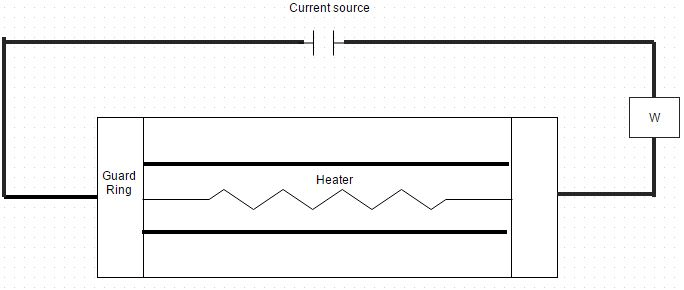This set of Heat Transfer Multiple Choice Questions & Answers (MCQs) focuses on “Effect Of Variable Conductivity”.
1. With variable thermal conductivity, Fourier law of heat conduction through a plane wall can be expressed as
a) Q = -k0 (1 + β t) A d t/d x
b) Q = k0 (1 + β t) A d t/d x
c) Q = – (1 + β t) A d t/d x
d) Q = (1 + β t) A d t/d x
View Answer
Explanation: Here k0 is thermal conductivity at zero degree Celsius.
2. The inner and outer surfaces of a furnace wall, 25 cm thick, are at 300 degree Celsius and 30 degree Celsius. Here thermal conductivity is given by the relation
K = (1.45 + 0.5 * 10-5 t2) KJ/m hr deg
Where, t is the temperature in degree centigrade. Calculate the heat loss per square meter of the wall surface area?
a) 1355.3 kJ/m2 hr
b) 2345.8 kJ/m2 hr
c) 1745.8 kJ/m2 hr
d) 7895.9 kJ/m2 hr
View Answer
Explanation: Q = -k A d t/d x, Q d x = – k A d t = – (1.45 + 0.5 * 10-5 t2) A d t. Integrating over the wall thickness δ, we get Q = 436.45/0.25 = 1745.8 kJ/m2 hr.
3. A plane wall of thickness δ has its surfaces maintained at temperatures T1 and T2. The wall is made of a material whose thermal conductivity varies with temperature according to the relation k = k0 T2. Find the expression to work out the steady state heat conduction through the wall?
a) Q = 2A k0 (T 1 3 – T 2 3)/3 δ
b) Q = A k0 (T 1 3 – T 2 3)/3 δ
c) Q = A k0 (T 1 2 – T 2 2)/3 δ
d) Q = A k0 (T 1 – T 2)/3 δ
View Answer
Explanation: Q = -k A d t/d x = k0 T2 A d t/d x. Separating the variables and integrating within the prescribed boundary conditions, we get Q = A k0 (T 1 3 – T 2 3)/3 δ.
4. The mean thermal conductivity evaluated at the arithmetic mean temperature is represented by
a) km = k0 [1 + β (t1 – t2)/2].
b) km = k0 [1 + (t1 + t2)/2].
c) km = k0 [1 + β (t1 + t2)/3].
d) km = k0 [1 + β (t1 + t2)/2].
View Answer
Explanation: At arithmetic mean temperatures i.e. (t1 + t2)/2.
5. With respect to the equation k = k0 (1 +β t) which is true if we put β = 0?
a) Slope of temperature curve is constant
b) Slope of temperature curve does not change
c) Slope of temperature curve increases
d) Slope of temperature curve is decreases
View Answer
Explanation: As temperature profile is linear so it is constant.
6. The accompanying sketch shows the schematic arrangement for measuring the thermal conductivity by the guarded hot plate method. Two similar 1 cm thick specimens receive heat from a 6.5 cm by 6.5 cm guard heater. When the power dissipation by the wattmeter was 15 W, the thermocouples inserted at the hot and cold surfaces indicated temperatures as 325 K and 300 K. What is the thermal conductivity of the test specimen material?

a) 0.81 W/m K
b) 0.71 W/m k
c) 0.61 W/m K
d) 0.51 W/m K
View Answer
Explanation: Q = k A (t 1 – t 2)/δ. So, k = 0.71 W/m K.
7. If β is greater than zero, then choose the correct statement with respect to given relation
k = k0 (1 +β t)
a) k doesn’t depend on temperature
b) k depends on temperature
c) k is directly proportional to t
d) Data is insufficient
View Answer
Explanation: k increases with increases temperature.
8. The unit of thermal conductivity doesn’t contain which parameter?
a) Watt
b) Pascal
c) Meter
d) Kelvin
View Answer
Explanation: Its unit is W/m K.
9. The temperatures on the two sides of a plane wall are t1 and t2 and thermal conductivity of the wall material is prescribed by the relation
K = k0 e (-x/δ)
Where, k0 is constant and δ is the wall thickness. Find the relation for temperature distribution in the wall?
a) t 1 – t x / t 1 – t 2 = x
b) t 1 – t x / t 1 – t 2 = δ
c) t 1 – t x / t 1 – t 2 = δ/x
d) t 1 – t x / t 1 – t 2 = x/δ
View Answer
Explanation: Q = -k A d t/d x = -k0 e (-x/δ) d t/d x. Separating the variables and upon integration, we get Q/k0 A = (t 1 – t 2)/ δ (e – 1). Therefore heat transfer through the wall, Q = k0 A (t 1 – t 2)/ δ (e – 1). At x = x and t = t x we get the answer.
10. “If β is less than zero, then with respect to the relation k = k0 (1 + β t), conductivity depends on surface area”.
a) True
b) False
View Answer
Explanation: k decreases with increasing temperature.
Sanfoundry Global Education & Learning Series – Heat Transfer.
To practice all areas of Heat Transfer, here is complete set of 1000+ Multiple Choice Questions and Answers.
If you find a mistake in question / option / answer, kindly take a screenshot and email to [email protected]
- Check Mechanical Engineering Books
- Check Chemical Engineering Books
- Apply for Chemical Engineering Internship
- Practice Mechanical Engineering MCQs
- Apply for Mechanical Engineering Internship
